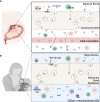Maternal vaccination: shaping the neonatal response to pertussis
- PMID: 37520565
- PMCID: PMC10374427
- DOI: 10.3389/fimmu.2023.1210580
Maternal vaccination: shaping the neonatal response to pertussis
Abstract
Antepartum maternal vaccination can protect highly sensitive newborns before they are old enough to receive their own vaccines. Two vaccines are currently recommended during pregnancy: the flu vaccine and the Tdap vaccine against tetanus, diphtheria, and pertussis. Although there is strong evidence that maternal vaccination works to protect the offspring, limitations in the understanding of vaccines and of maternal transfer of immunity compound to obscure our understanding of how they work. Here we focus on the example of pertussis to explore the possible mechanisms involved in the transfer of protection to offspring and how these may impact the newborn's response to future exposure to pertussis. For example, Tdap vaccines induce pathogen specific antibodies, and those antibodies are known to be transferred from mother to the fetus in utero and to the newborn via milk. But antibodies alone have modest impact on pertussis disease, and even less effect on colonization/transmission. Maternal immune cells can also be transferred to offspring and may play a direct role in protection from disease and/or influence the developing neonatal immune system. However, some of the transferred immunity may also blunt the offspring's response to subsequent vaccination. In this review we will summarize the protection conferred to offspring by maternal vaccination against pertussis and the likely mechanisms by which protection is transferred, identifying the many knowledge gaps that limit our most effective application of this approach.
Keywords: DTaP; Tdap; maternal vaccination; neonatal immunity; pertussis; vaccines; window of opportunity.
Copyright © 2023 Callender and Harvill.
Conflict of interest statement
The authors declare that the research was conducted in the absence of any commercial or financial relationships that could be construed as a potential conflict of interest.
Figures



Similar articles
-
Impact of maternal diphtheria-tetanus-acellular pertussis vaccination on pertussis booster immune responses in toddlers: Follow-up of a randomized trial.Vaccine. 2021 Mar 12;39(11):1598-1608. doi: 10.1016/j.vaccine.2021.02.001. Epub 2021 Feb 19. Vaccine. 2021. PMID: 33612341 Clinical Trial.
-
Efficiency of placental transfer of vaccine-elicited antibodies relative to prenatal Tdap vaccination status.Vaccine. 2020 Jun 26;38(31):4869-4876. doi: 10.1016/j.vaccine.2020.05.036. Epub 2020 May 29. Vaccine. 2020. PMID: 32482459 Free PMC article.
-
Quantity and Quality of Antibodies After Acellular Versus Whole-cell Pertussis Vaccines in Infants Born to Mothers Who Received Tetanus, Diphtheria, and Acellular Pertussis Vaccine During Pregnancy: A Randomized Trial.Clin Infect Dis. 2020 Jun 24;71(1):72-80. doi: 10.1093/cid/ciz778. Clin Infect Dis. 2020. PMID: 31418814 Clinical Trial.
-
Prevention of pertussis, tetanus, and diphtheria among pregnant and postpartum women and their infants recommendations of the Advisory Committee on Immunization Practices (ACIP).MMWR Recomm Rep. 2008 May 30;57(RR-4):1-51. MMWR Recomm Rep. 2008. PMID: 18509304 Review.
-
Maternal immunization: trends in South and Southeast Asian countries.J Matern Fetal Neonatal Med. 2022 Dec;35(25):8372-8381. doi: 10.1080/14767058.2021.1974389. Epub 2021 Sep 13. J Matern Fetal Neonatal Med. 2022. PMID: 34517746 Review.
Cited by
-
Highlights of the 14th International Bordetella Symposium.mSphere. 2025 Jun 25;10(6):e0018925. doi: 10.1128/msphere.00189-25. Epub 2025 May 16. mSphere. 2025. PMID: 40377335 Free PMC article. Review.
-
Resurgence of pertussis: Epidemiological trends, contributing factors, challenges, and recommendations for vaccination and surveillance.Hum Vaccin Immunother. 2025 Dec;21(1):2513729. doi: 10.1080/21645515.2025.2513729. Epub 2025 Jun 9. Hum Vaccin Immunother. 2025. PMID: 40491090 Free PMC article. Review.
-
Sources and clinical characteristics of infant pertussis in China: increasing contribution of siblings.BMC Infect Dis. 2025 Feb 10;25(1):198. doi: 10.1186/s12879-025-10536-y. BMC Infect Dis. 2025. PMID: 39930341 Free PMC article.
-
Impact of Infections During Pregnancy on Transplacental Antibody Transfer.Vaccines (Basel). 2024 Oct 21;12(10):1199. doi: 10.3390/vaccines12101199. Vaccines (Basel). 2024. PMID: 39460363 Free PMC article. Review.
-
Maternal Pertussis Immunization and Immunoglobulin G Levels in Early- to Late-Term and Preterm Infants.JAMA Netw Open. 2024 Jul 1;7(7):e2424608. doi: 10.1001/jamanetworkopen.2024.24608. JAMA Netw Open. 2024. PMID: 39078627 Free PMC article.
References
-
- Pregnancy and vaccination - vaccine safety. CDC; (2022).
Publication types
MeSH terms
Substances
Grants and funding
LinkOut - more resources
Full Text Sources
Medical

